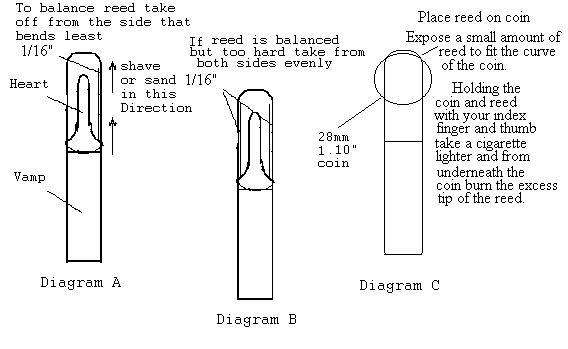Col Loughnan's Reed Adjustment Tips
Col Loughnan currently teaches saxophone and woodwinds in the Jazz Departments
of the Sydney Conservatorium of Music and the Queensland Conservatorium of Music.
He is well known in Australia as a soloist, composer and arranger, and has worked
with artists as varied as Frank Sinatra, the Toshiko Tabakin Orchestra, Sammy
Davis Jnr., Freddie Hubbard, Georgie Fame, and the Sydney Symphony Orchestra.
He studied in the United States with Joe Allard, Eddie Daniels and Victor Morosco.
Check out his latest stunning Cd

Adjusting Saxophone Reeds
More unpredicatable than the weather, reeds remain a constant problem
for most saxophone players. How many times have you gone to the local
music store, purchased a new box of reeds, gone home, tried them out,
and to your amazement and frustration found that the whole box was
unplayable.
The tips below are based on personal trial and error and as
a result of studying with the great master teacher, Joe Allard, who could
magically transform the worst reed ever into a good playable reed.
Balancing The Reed
The problem with many reeds is that they are not balanced. In other words,
one side of the reed may be thicker than the other causing an inbalance,
and making the reed respond poorly in various registers. The first thing to
do is test the sides of the reed.
Placing the instrument into your mouth as normal, tilt or rotate the mouthpiece
to the left closing off the left side and exposing the right side which will vibrate.
Blow a note (middle C Sharp for example), tilt the mouthpiece to the right closing
off the right side and exposing the left side to vibrate. Blow a note---compare
the two sounds, if one side sounds dull, airy, or is just harder to blow, that will
be the side we want to adjust. After testing the reed by playing both sides, you
can do a further test, by feeling underneath either side of the the reed, going
towards the tip area and bending the reed up SLIGHTLY with one finger, one
side at a time. The side that bends the least is the side that has more wood on
it, and is the side that you will adjust. Using either, medium sand paper, a one
sided razer blade, or a reed knife, scrape the side to be adjusted.
Start in about 1/16" of an inch, and at the vamp, where the slope of the reed
ends. Start at the vamp and work slowly towards the tip. Stop about 1/16"
from the tip. Take very little wood as you get towards the tip, take more from
the vamp to about 1/2 way down the reed.
See Diagram A
Test the reed, blowing both sides as before, and adjust until both sides of the
reed are equal in sound and response.
See Diagram B
N.B. Avoid touching the heart of the reed, as this may result in the reed
sounding unfocused and difficult to play in tune.
Reed Too Soft
If a reed is too soft, you can either:
1. Place the reed further over the tip of the mouthpiece.
2. Clip the reed using a reed clipper.
3. Burn the tip of the reed.
See Diagram C
Clipping the reed, usually makes the reed sound a little dull, burning the
reed however, seems to retain and in some cases brighten the sound of
the reed.
As in clipping, take the smallest amount possible, test and
repeat, until the desired strength is achieved.
Polishing The Back Of The Reed
Using a flat surface, (table, bench top etc.) place a white piece of A4
paper on the table---holding the paper so it will not move, place the
reed in the center of the page, using your strong hand, press the 1st
two fingers ( index and 2nd ) of your hand onto the reed. Going clockwise
or anticlockwise, rotate the reed in a circular motion, fast, and about
100 turns, this will polish, the flat side of the reed and make sure it
forms a perfect "seal" to the mouthpiece.
See Diagram D

This is especially helpeful when the reed has been played for a few days,
as with moisture on it the fibres of the back of the reed may swell.
Buying another box of reeds may help you find the 'magic reed', but you
may end up spending more that day on reeds than your gig is worth.
Feeling comfortable with the strength and sound quality of the reed, is
a must if you wish to play well and to be creative. We can not be creative,
if we are struggling to play poor equipment or a bad reed.
I hope these tips on reed adjusting may help you as they have me.
Happy reed adjusting!!
Copyright 1995 Col Loughnan. Reproduction
of this article for other than private use is not permitted without the written
consent of the author.
Col loughnan. Sydney Conservatorium of Music. Jazz Dept. Mcquarie St. Sydney
2000. N.S.W. Australia.
Brendan Tibbs Home Page


